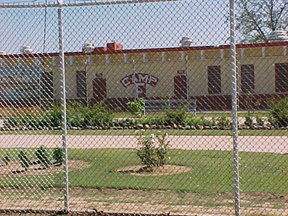Going to the Source
About a month or two after her initial phone call, Sullivan decided it was time to call Angolas spokesperson again. She needed to visit the prison and interview the prisoners, and she wanted to see as many sites as possible linked to the two men held in solitary for so many years.
I decided that if were going to do this, we need to go [there], and I knew that we would not get everything we need, that the story wasnt going to come together in one trip. I already knew that there were a million avenues that I was going to want to chase down. This oneI wanted to hit the hot spots, you know, and try to just get as much as we could.
Under US law, no one had a legal right to enter a corrections facility without permission. The warden had the discretion to choose who could or could not come through the gates. Thanks to her years covering prisons, Sullivan had become adept at negotiating with wardens and other prison administrators and navigating bureaucracies. Typically, she convinced officials of a storys importance by outlining her reasons for doing it, its effect on the publics understanding of an issue, and the benefits the story might have for the warden and his or her prison.
Before Sullivan reached for the phone, she thought it through. I did not want in any way to lie or mislead them, but I needed access, she says. Without access, she had no story. It would have been possible to claim that she simply wanted to re-interview the elderly inmate for the other story she was working on, then surprise the prison authorities with a request to see Woodfox and Wallace. But Sullivan knew better. You cannot in any way tell a warden you are coming to do one story and then do something else, she says.
This job is hard enough as it is. You are your reputation, and the only reason you get access to prisons or you are allowed to come back is because they trust youre going to be true to your word.
On the other hand, if she called to ask forthrightly for an interview with the inmates in solitary confinement, they would slam the door in her face. She hoped that she could negotiate with the prison officials. Before she picked up the phone, she plotted a strategy she hoped would work: leave no room for a rejection. I would like to come down and interview [the elderly inmate] again, she said to the spokesperson, and I would like to talk to you while Im there about Woodfox and Wallace. The woman reminded Sullivan that prison officials would have nothing to say about those two. But Sullivan deliberately did not press her. Lets not be hasty, Sullivan says. Why dont we talk about it when I get there?
Trip to Angola. Sullivan scheduled a trip to Louisiana for early July 2008. Amy Walters, her producer, joined her. Once in Angola, Sullivan met with the warden, Burl Cain, and repeated the request she had made to the spokesperson. We dont talk about those. Just cant do it, you know, really. Thats not the deal, he told her. [1] So she collected what material she could without talking to them.
A radio reporter needs tape of ambient soundrecordings that in this case would convey the daily sounds of the prison to her listeners. To satisfy this need, Sullivan asked for a tour of the prison, making it clear to the warden that she was pursuing both stories: the one about the elderly inmate, and the one about Woodfox and Wallace. To her relief, he allowed her to take the tour. But he stipulated that she could not interview anyone about Woodfox and Wallace. Sullivan acquiesced, hoping that in the course of the tour, she would pass by some of the spots that figured in the story of the isolated prisoners, such as Brent Millers former residence or the crime scene. Melody Spragg, an Angola administrator, served as her escort. When Sullivan asked Spragg whether she could see the Brent Miller Firing Range, which was named for the slain guard, she responded: Absolutely not.

Camp F, which holds 4 inmate dormitories and the dog pen.
Courtesy Louisiana State Department of Corrections
The tour was short, conducted by car, and tightly controlled. Spragg drove her through the neighborhood where prison employees lived and by the dog pen. The bloodhounds, attack dogs, and wolves were used to track down escaped inmates. Sullivan didnt let on that she was pleased to visit the dog pen, where she made recordings of barking hounds. She knew from her research that Hezekiah Brown, who had been the states main witness against Woodfox and Wallace, had been assigned to oversee the dog pen as a reward. It was a very luxurious place to go, and that was his gift for testifying against the two men, she says.
Every time she was allowed out of the car, Sullivan recorded more sound. At an abandoned building that had been shuttered decades earliera lone shack in a fieldSullivan taped chirping cricket ambi. But the tape she had gathered so far was insufficient for her solitary confinement story. Can I at least see where [Woodfox and Wallace] were in solitary? Sullivan asked Spragg, hoping at the very least to catch a glimpse of the buildings exterior. Again, the answer was no. Sullivan had made her site visit, but collected very little usable material.
Listen to Sullivan talk about the tour.
[1] Laura Sullivan, Doubts Arise About 1972 Angola Prison Murder, All Things Considered , National Public Radio, October 27, 2008. Other interview details, unless separately attributed, are from this story.